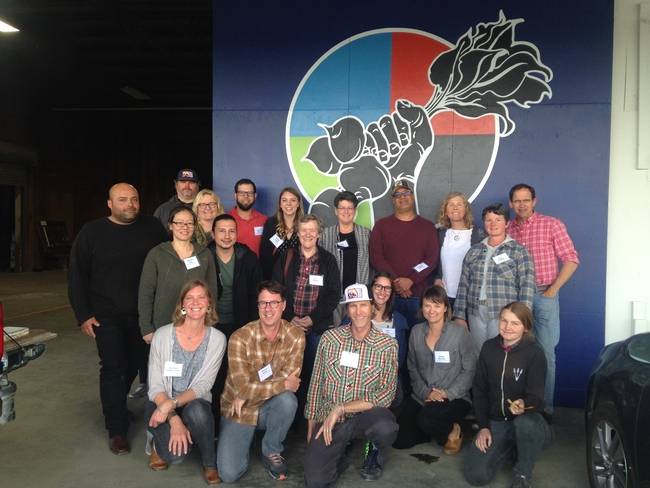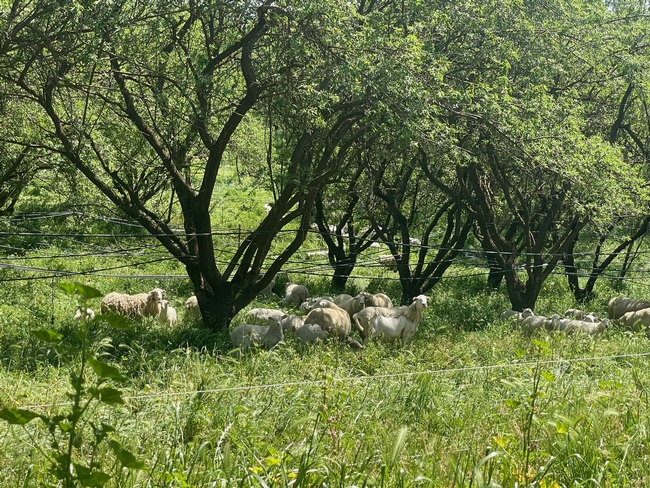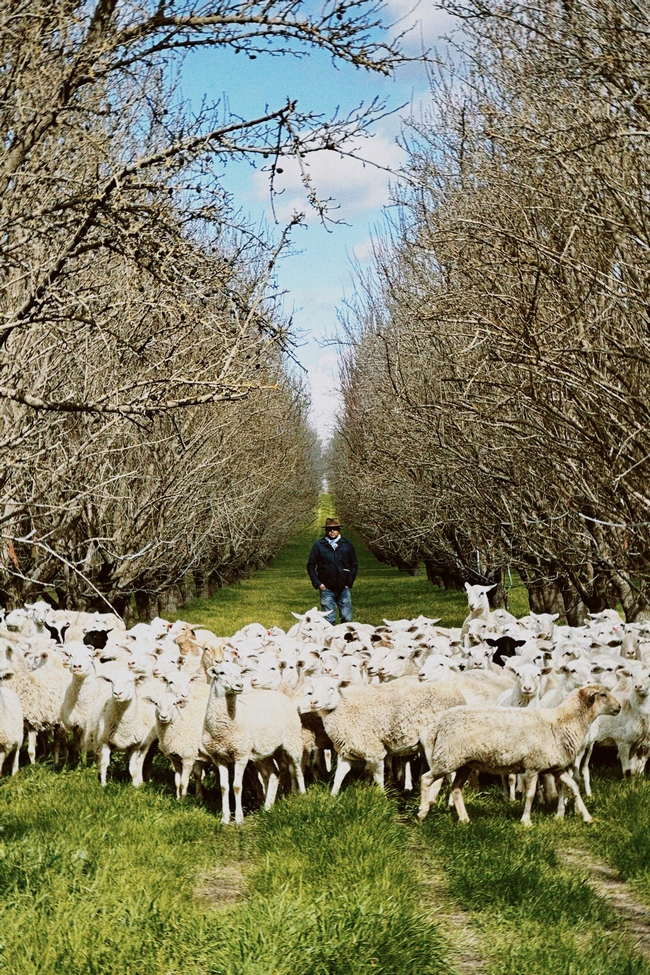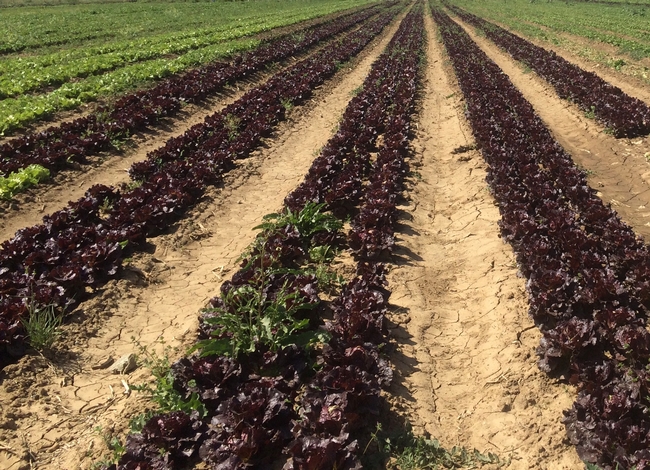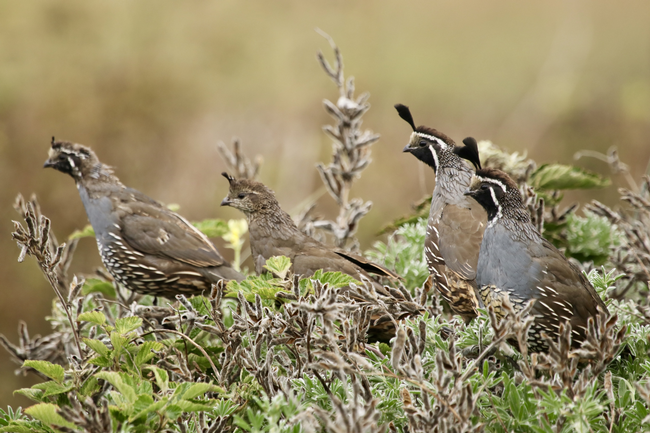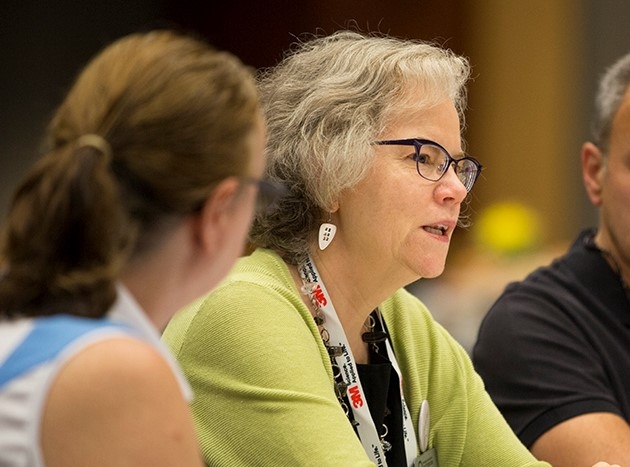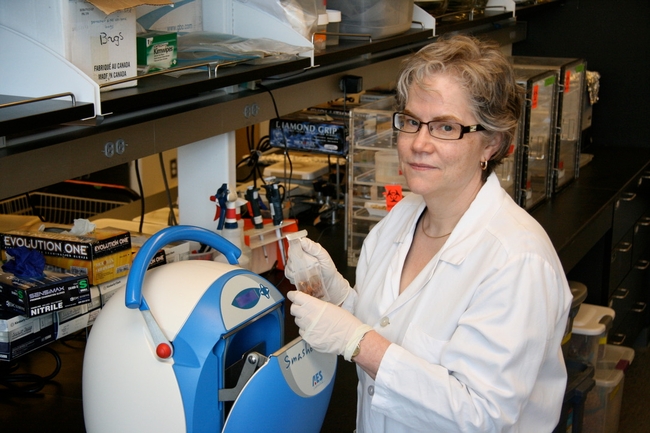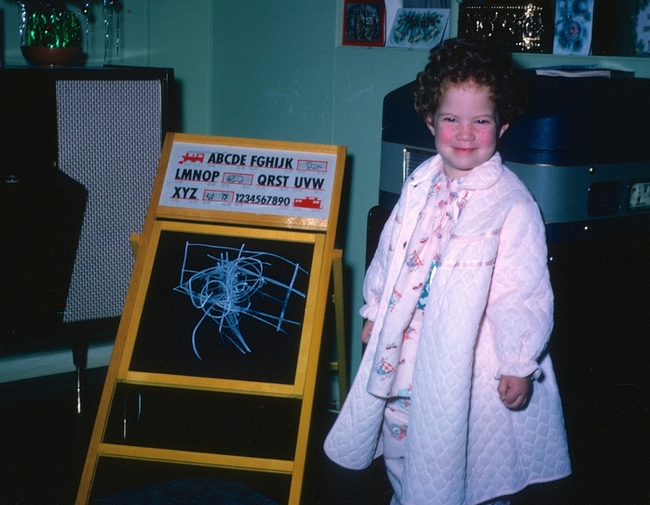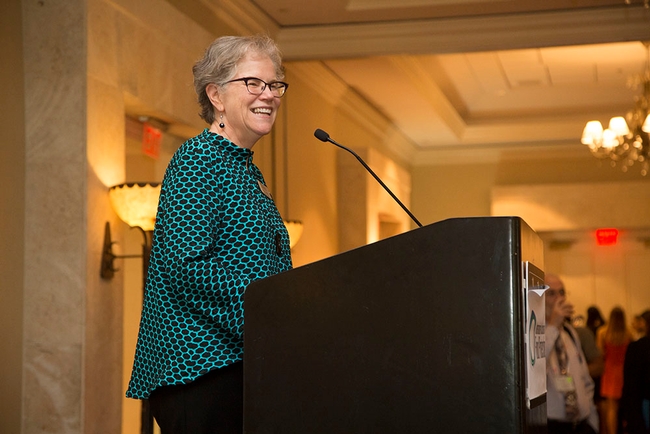
Posts Tagged: food safety
Winter season: A time for food safety systems re-evaluation and education for food hubs
The holiday meal season is often a busy time for food hubs – entities that handle the aggregation, distribution and/or marketing of source-identified regional food – as restaurants, retailers and consumers fill their tables and shelves with an abundance of fresh, local products. However, the subsequent winter months can provide a valuable time for reflection and re-evaluation of a food hub's systems and processes. In this spirit, it may be helpful to remind people working at food hubs that University of California Sustainable Agriculture Research and Education Program (UC SAREP) offers a suite of food-safety resources – in English and in Spanish – on its website.
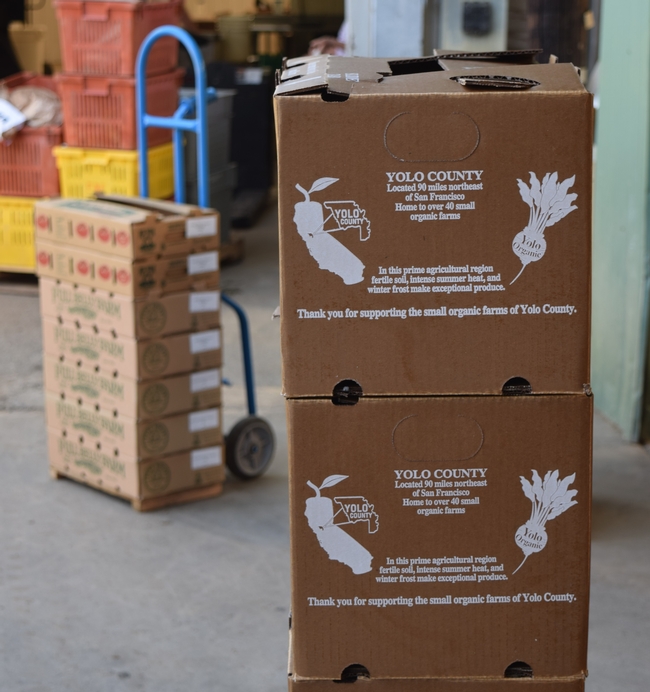
- A step-by-step guide for food hubs on how to pursue a third-party food safety audit with guidance on how to navigate buyers' questions.
- Two sample food-safety plans intended as a starting point to be adapted to a food hub's specific operations and practices.
- Example standard operating procedure, or SOP, documents related to 11 common tasks carried out by food hubs.
“We hope these resources can play a role in helping food hubs to adopt best practices and control risks related to food safety,” says Gwenael Engelskirchen, sustainable food and farming coordinator with UC SAREP, who led the development of these educational tools.
According to the Centers for Disease Control and Prevention, approximately, 1 in 6 Americans (or 48 million people) gets sick and 3,000 die of foodborne diseases annually. In 2011, to help prevent the occurrence of foodborne illness, the federal government enacted the Food Safety Modernization Act (FSMA), designed to outline actions to be taken at various points along the supply chain for both human and animal food.
UC SAREP's Food Safety Resources for Food Hubs are intended to help food hubs navigate these food-safety regulations and accompanying best practices. Resources are also available in Spanish at Recursos de seguridad alimentaria para los centros de distribución de alimentos.
Food safety certification guide
Some buyers verify a supplier's food safety program by requiring an audit performed by a third-party certification body or auditing company. This Guide to Food Safety Certification offers key considerations before deciding to pursue a food safety audit and helps users navigate the food safety certification process.
Food safety plan
Food hubs that meet the criteria for full compliance with FSMA's Preventive Controls for Human Food Rule are required to have a food-safety plan in place. And for all food hubs, having a shared document describing the facility's operations and how potential risks of food contamination are managed is a good idea. Two sample food safety plans, inspired by the operations of food hubs in California, provide a starting point and can be adapted to a hub's own operations.
Standard operating procedures
Standard operating procedures provide detailed step-by-step instructions for how to carry out operational tasks within a food facility. The standard operating procedure samples cover common topics such as handwashing, facility cleaning and more, and are intended to be adapted to a food hub's specific operations and practices.
Jacob Weiss from Spork Food Hub in Davis said, “the templates were a great starting place for us to build the framework of our food safety plan. It helped us figure out what we needed to (and didn't) need to include. I think the SOPs are also really useful because they are broad enough to get you started but flexible enough to add the specific practices of your business or hub.”
For additional information, visit UC SAREP's webpages on Food Safety Resources for Food Hubs or Recursos de seguridad alimentaria para los centros de distribución de alimentos.
These resources and tools were developed in collaboration with various project partners, including Department of Food Science and Technology at UC Davis, Department of Population Health and Reproduction at UC Davis School of Veterinary Medicine, Center for Precision Medicine and Data Science at UC Davis Health, and Community Alliance with Family Farmers.
USDA awards $2 million to study livestock grazing in organic orchards
UC, The Organic Center, University of Rhode Island partner on $3.5m food-safety study for organic produce growers
Grazing sheep and other livestock can help convert cover crops to fertilizer for orchard crops. To develop best management practices, the University of California and The Organic Center are collaborating on research to help organic orchard growers safely incorporate livestock grazing into their farming practices. The project is funded by a $2 million grant recently awarded through the U.S. Department of Agriculture's Organic Agriculture Research and Extension Initiative research program.
Interest in grazing livestock on cover crops in nut orchards has increased in recent years. However, research is needed to determine the best way to improve soil health and pest suppression, and to address concerns about food-borne pathogens and food safety.
“Organic farmers typically follow the USDA National Organic Program standards for raw animal manure, waiting 90 to 120 days between incorporating raw manure into the soil and harvesting the crop,” said Alda Pires, UC Cooperative Extension urban agriculture and food safety specialist in the School of Veterinary Medicine at UC Davis.
“Little research has been conducted to verify adequate waiting periods to reduce contamination risks in integrated crop-livestock production systems,” she said. “This research will fill the knowledge gap and facilitate the development of science-based food safety guidelines for grazing small ruminants in orchards.”
For this four-year project, “Influence of Orchard Grazing on Soil Health and Pest Control While Mitigating Food Safety Risk,” the scientists will study organic almond, walnut and pistachio orchards in two distinct nut-growing regions in California – the Sacramento Valley and San Joaquin Valley. The scientists will assess the effects of livestock grazing of cover crops on bacteria populations, soil health, pest control and economics.
Building soil health
“Growers have consistently raised the need for more information on grazing impacts on nutrient availability during tree growth, as well as potential to build up the biological, physical and chemical pillars of soil health,” said Amelie Gaudin, associate professor and endowed chair of agroecology in the UC Davis Department of Plant Sciences.
Livestock grazing may provide an opportunity to quickly enhance the amount of nitrogen that can be used by plants and microbes when the cover crop is terminated. “This project will help growers develop nitrogen budgets for these more diversified systems and quantify additional benefits and potential tradeoffs for soil health – such as compaction and salinity – to guide the development of place-based best management practices,” Gaudin said.
Pest management
Houston Wilson, UC Cooperative Extension specialist in the Department of Entomology at UC Riverside, will be studying the effects of livestock grazing on orchard pests.
“Navel orangeworm, or NOW, is by far the most destructive pest of almonds and pistachios,” Wilson said. “These moths overwinter in unharvested nuts in the orchard, and so removal and destruction of remnant nuts over the winter is the foundation of NOW control. While farmers typically use machinery to do this, grazing with animals may present a unique alternative that is more cost-effective and provides additional ecosystem benefits, such as soil health and weed control.”
Outreach to farmers
As part of the project, The Organic Center was awarded $75,000 to work with UC Agriculture and Natural Resources to direct national extension and education outreach activities. These will include a social media campaign, webinars and educational sessions and a technical report for growers.
“There is an increasing interest from organic farmers to learn how to incorporate livestock into their operations to gain better soil health and fertility,” said Amber Sciligo, director of science programs at The Organic Center.
“This research is very exciting because it will holistically explore the potential risks and benefits of livestock not just to soil health, but also pest control – a truly interdisciplinary project that matches the whole system of the organic farm.”
Produce food-safety management tools
For another organic food-safety project, Pires and Sciligo will be working with Patrick Baur, professor of Sustainable Agriculture and Food Systems at the University of Rhode Island.
The University of Rhode Island and The Organic Center received $3.5 million from USDA's Organic Agriculture Research and Extension Initiative research program for the new organic food-safety education project.
“We're going to develop a new food safety management tool designed specifically for organic soil amendments,” said Baur, who is leading the project. “We're also going to develop a suite of new communication and training tools aimed at the entire fruit and vegetable sector to build a shared language between organic agriculture and the food safety community and help them work better together.”
As part of the produce project, Pires of UC Davis was awarded $1.16 million to conduct a risk assessment and create a publicly accessible dashboard to meet the specific needs of organic growers operating at different scales, under different cropping systems, in different regions.
Also participating in this project will be Beatriz Martinez Lopez, professor in the School of Veterinary Medicine at UC Davis, and Abhinav Mishra and Govindaraj Dev Kumar of the University of Georgia.
Hotel refrigerators vary in temperature
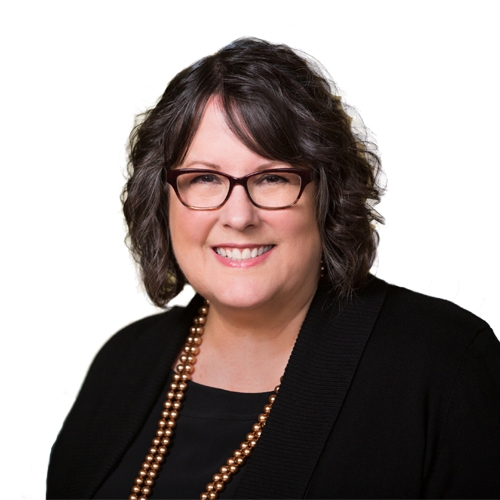
A few years ago, I was in Reno overnight for work and wanted to save my delicious dinner leftovers for breakfast. But when I opened the mini refrigerator in my room, my first reaction was, "That feels too warm!" I did not save the leftovers and made alternative plans for breakfast. Since then, I've wondered how common an unsafe hotel refrigerator might be.
The pandemic delayed my research as travel was out of the question for a while. This year, I had the opportunity to test my question when I traveled up the coast from California to Washington and back home again on vacation. I stayed in a variety of places, perfect for my casual research project. My trusty refrigerator thermometer came with me. The results: mixed!
Of the five hotels I stayed in:
- One in-room refrigerator was too warm to store food safely overnight.
- Two were too cold. One was so cold, it froze the beverage I placed inside. Not optimal, but better than food poisoning!
- Two tested perfectly in the safe zone for food storage.
The score: One out of five refrigerators in my unscientific study was unsafe. One in five is not great odds.
The Ideal Refrigerator Temperature
A temperature range of 33 F to 40 F is ideal. Refrigeration in this range slows the growth of microorganisms, including bacteria. Safe food-handling practices advise that food should be held for no more than two hours above 40 F. Keeping food overnight above that temperature could have serious consequences, meaning storing food in hotel refrigerators that are not 40o F or below for more than two hours can have serious consequences.

Stay Safe When You Travel
Here are three ideas to help you avoid problems when you travel:
1) Measure. Take a refrigerator thermometer with you if you plan to use the in-room mini refrigerator. There's nothing like data to let you know the refrigerator is at the right temperature. Refrigerator thermometers are readily available at grocery and hardware stores, and online.
2) Avoid. Consider not storing anything that might spoil in your hotel refrigerator if you do not know the temperature setting. Cooling sealed canned beverages would be fine. At worst, your beverage will not be as cool as you hoped, but because it's sealed, nothing will spoil.
3) Take a quality cooler. Since I was driving, I took my cooler, one that holds appropriate temperatures for days. Traveling with a ready supply of ice, beverages and confidence that my groceries were held safely below 40 F was lovely. This solution is not for every trip, and of course, you need to replenish the ice as you go.
As you plan your future travel, I wish you a safe journey and a skeptical mindset on the safety of your hotel refrigerator for food storage.
Do you have any questions about safe food storage? You can find your local UC Master Food Preserver program or submit questions at http://mfp.ucanr.edu. You can also sign up to be notified of upcoming online food preservation classes.
Bringing out the best in wild birds on farms
Natural habitat maximizes the benefits of birds for farmers, food safety and conservation
A supportive environment can bring out the best in an individual — even for a bird.
After an E.coli outbreak in 2006 devastated the spinach industry, farmers were pressured to remove natural habitat to keep wildlife — and the foodborne pathogens they can sometimes carry — from visiting crops. A study published today from the University of California, Davis, shows that farms with surrounding natural habitat experience the most benefits from birds, including less crop damage and lower food-safety risks.
The study, published in the Journal of Applied Ecology, was conducted at 21 strawberry fields along California's Central Coast. It found that birds were more likely to carry pathogens and eat berries without surrounding natural habitat.
The authors said a better understanding of the interplay of farming practices, the landscape, and the roles birds play in ecosystems can help growers make the most out of wild birds near their fields.
“Bird communities respond to changes in the landscape,” said lead author Elissa Olimpi, a postdoctoral scholar in the UC Davis Department of Wildlife, Fish and Conservation Biology at the time of the study. “As birds shift in response to management, so do the costs and benefits they provide.”
The single most important driver
The study looked at how different farming practices influenced the costs and benefits that wild birds provided on the strawberry farms. The scientists combined nearly 300 bird surveys and the molecular analyses of more than 1,000 fecal samples from 55 bird species to determine which birds ate pests, beneficial insects and crops, and carried foodborne pathogens.
They also ranked birds to see which were more likely to bring benefits or costs to farmlands. Barn swallows, for instance, got a “gold star” in the study, Olimpi said. Their mud nests are commonly seen clinging to the underside of barn eaves, from which they fly out to swoop over fields, foraging on insects.
But rather than resulting in a list of “good” and “bad” birds, the study found that most bird species brought both costs and benefits to farms, depending on how the landscape was managed.
The presence of natural habitat was the single most important driver differentiating a farm where wild birds brought more benefits than harm.
“Nature is messy, and birds are complex,” Olimpi said. “The best we can do is understand how to take advantage of the benefits while reducing the harms. Growers will tell you it's impossible to keep birds off your farm — you can't do that and don't want to from a conservation perspective. So how can we take advantage of the services birds provide?”
Win-wins for birds and farms
The study is one of several publications from UC Davis Professor Daniel Karp's lab highlighting the environmental, agricultural, and food safety impacts of conserving bird habitat around farms. A related study in 2020 found that farms with natural habitat attracted more insect-eating birds — and fewer strawberry-eating birds — so that farmers experience less berry damage on farms with more habitat nearby. Such habitats also bring greater numbers of bird species to the landscape.
“All together, these studies suggest that farming landscapes with natural habitat tend to be good for conservation, farmers, and public health,” said Karp.
Additional co-authors of this study include Karina Garcia and David Gonthier of University of Kentucky, Claire Kremen of UC Berkeley and the University of British Columbia, William E. Snyder of University of Georgia, and Erin Wilson-Rankin of UC Riverside.
The research was funded by the USDA and UC Davis Department of Wildlife, Fish and Conservation Biology.
Five questions with food safety expert, new AAAS Fellow Linda Harris
Professor of Cooperative Extension shares career story, appreciation for UC Davis
After growing up in northern British Columbia, in a remote smelter town called Kitimat (“an 8-hour drive from the nearest McDonald's”), University of California Professor of Cooperative Extension Linda J. Harris embarked on an academic journey that crisscrossed North America and eventually led to her election as a Fellow of the American Association for the Advancement of Science.
AAAS, the world's largest multidisciplinary scientific society and publisher of the journal Science, recently announced the election of its 2021 class, which will be inducted during its annual meeting, Feb. 17-20.
In addition to Harris – a faculty member in UC Davis' Department of Food Science and Technology – four other UC Agriculture and Natural Resources affiliates will be inducted: Helene Dillard, dean of the UC Davis College of Agricultural and Environmental Sciences; Kathryn Uhrich, dean of the UC Riverside College of Natural and Agricultural Sciences; and UC Berkeley Professors Rodrigo Almeida and Paolo D'Odorico.
Harris, a Certified Food Scientist, recently shared her thoughts on the value of extension work, her contributions to the field, UC Davis' support for women in academia, and the arc of her career journey.
How did you get your start in food science and microbiology?
I was interested in science at an early age. As an undergraduate student at the University of Victoria in Victoria, B.C., I enrolled in biochemistry at the suggestion of my high school biology teacher. In my second year, I switched to the University of Alberta in Edmonton, Alberta and decided to review the course catalog – a paper version! When I got to the section on Food Science, the applied nature of the field just sounded right and I never looked back.
However, I didn't do particularly well in microbiology as an undergraduate student – too much memorization for me. At the end of my B.S. I was ready for a job in the food industry and took the very first job I was offered – ironically enough as a dairy microbiologist in a quality control lab. Thankfully, that job opened my eyes to the possibilities in microbiology. What was memorization turned into something I learned through doing and I was hooked.
Two years later, I was ready to go back to school and contacted a professor of food safety microbiology at the University of Alberta who fortunately had funding for me. During my M.S. degree in food microbiology, he encouraged me to pursue the Ph.D. – which was not something I had ever considered – and that led me to leave Canada and head to North Carolina State University and a Ph.D. in microbiology in the Food Science Department, where I worked on a project related to the fermentation of sauerkraut.
I did have one publication related to food safety during my time at NC State, and when I took my first faculty position back in Canada [University of Guelph in Ontario] I continued to work in food safety, mostly with meat and meat products.
I am so glad that I saw the advertisement for my current position and that I followed my instincts to apply for the job. The opportunities to grow professionally and to work in the food safety area at UC Davis, within the Cooperative Extension network in California, and with collaborators across the U.S., and around the world, have been enormous, and I am extremely grateful for the path that led me here.
February 11 is the United Nations-designated “International Day of Women and Girls in Science.” How has UC Davis supported women in your scientific field?
My career in STEM [science, technology, engineering and math] has been very rewarding and many of the gender barriers I faced early on have been addressed. I feel very fortunate to have landed at UC Davis and I am thankful that there is a long history of addressing these barriers at this institution.
When I was hired in 1996, the Department of Food Science and Technology was about 25% women and both the department chair and dean of the college were women. I had never been in a department or college with so many women faculty, including in positions of leadership. It was a very important consideration in my move. Today our department is 50% women and I proudly served for five years as the second woman department chair, from 2016 to 2021.
As a first-generation university graduate raised by a single mother, you have a unique perspective in encouraging young people on their path toward a STEM career. What advice do you have for them?
To those contemplating a career in STEM, I would say: be open to new opportunities and adventures – you never know where they may lead you. Get involved in leadership in any capacity you can from student organizations or around other things that interest you. Skills that you learn with these types of activities will be invaluable to your career.
I am very much an introvert and had to work hard to overcome my fear of public speaking. In addition to leadership roles in student clubs, I joined Toast Masters while working on my Ph.D. These activities had a huge impact on building my confidence and helped influence my career choices.
In the AAAS Fellows announcement, it says you were elected for “contributions to the field of food safety microbiology, especially related to control of Salmonella and other pathogens in low-moisture foods and fresh produce.” Is that your proudest achievement in the field?
I am most proud of the work described by that short statement especially as it applies to California-grown commodities. I would say that my laboratory is best known for work with the tree nut industry – almonds, pistachios and walnuts, as well as a range of types of fresh produce grown in this state.
My laboratory has worked to understand behavior, movement, prevalence, and especially control of foodborne pathogens like Salmonella during production in the field through harvest and postharvest handling all the way through to consumer practices.
I have been fortunate to have many terrific state, national and international collaborators and an outstanding group of people working in my laboratory as we set the foundation for some of the food safety research in tree nuts and produce. It has been most gratifying to watch the significant growth in these fields of investigation, especially with a new generation of scientists that span the country and beyond.
Another “hat” you wear is UC Cooperative Extension specialist. How have you contributed to food safety knowledge and practices in our communities?
I think you will see that my “hats” are not that different. The research from my laboratory has provided the foundation for several commodity-based, food-safety risk assessments – for almonds, pistachios, and walnuts. And these, in turn, have been used in support of regulations or helped guide implementation of safer food industry practices. Our research has also informed several publications aimed at consumer handling of fresh fruits and vegetables and has been cited in regulations pertaining to fresh produce safety. It is gratifying to see our research being used.
My research and extension work are very integrated. One feeds the other. Because I have been able to interact with stakeholders (especially integral to my position as a Cooperative Extension specialist), I have been able to understand firsthand some of the pressing food-safety issues and challenges in California. These stakeholder interactions have largely formed the basis for most of my research and extension grant proposals over the years. The collaborations that have resulted from extension activities have opened doors and access to many unique opportunities for sample collection and research exploration.

